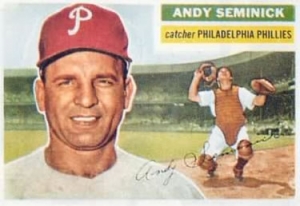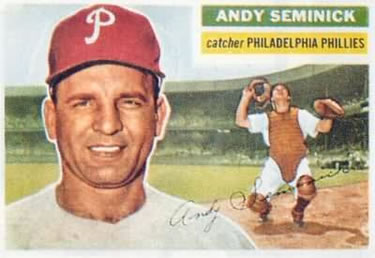June 2, 1949: Phillies smash 5 homers in one inning to tie major-league record
 The 1949 Philadelphia Phillies were in the middle of a youth movement under manager Eddie Sawyer, with uncertain results. The even-keel Sawyer had taken over the reins the previous July from the volatile Ben Chapman and, playing youngsters like Richie Ashburn, Del Ennis, Granny Hamner, Putsy Caballero, Johnny Blatnik, Curt Simmons, and Robin Roberts, had lost 41 of the final 64 games to finish in sixth place, only two games out of the National League cellar.1
The 1949 Philadelphia Phillies were in the middle of a youth movement under manager Eddie Sawyer, with uncertain results. The even-keel Sawyer had taken over the reins the previous July from the volatile Ben Chapman and, playing youngsters like Richie Ashburn, Del Ennis, Granny Hamner, Putsy Caballero, Johnny Blatnik, Curt Simmons, and Robin Roberts, had lost 41 of the final 64 games to finish in sixth place, only two games out of the National League cellar.1
The team hadn’t done much better to start the 1949 season, losing 8 of its first 11 games before starting to show improvement. The Phillies began June 2 in sixth place with a 19-21 won-lost record but stood only 4½ games behind the league-leading Boston Braves. The Phillies had defeated fifth-place Cincinnati, in town for a four-game series, 4-3 in 10 innings the previous evening to close to a game behind the Reds.
The June 2 night game featured two southpaws, the Phillies’ 20-year-old bonus baby Simmons versus the Reds’ crafty veteran Ken Raffensberger, before a crowd of 10,549. Phillies catcher Andy Seminick led off the bottom of the second with a home run for the game’s first run. Meanwhile, Simmons scattered doubles by Jimmy Bloodworth and Bobby Adams in the first four innings but otherwise kept the Reds in check. In the top of the fifth, however, Simmons allowed consecutive singles to Danny Litwhiler, Ray Mueller, and Johnny Wyrostek with no outs to tie the score. With two outs, Frank Baumholtz singled to left to drive in Wyrostek with the go-ahead run before Simmons retired Virgil Stallcup on a comebacker to end the inning.
The Phillies drew even at 2-2 in the bottom of the sixth on a bunt single by Hamner, a walk to Seminick, and a two-out single to center by Stan Hollmig. But Simmons could not hold the lead in the seventh, allowing doubles to Mueller and his opposite number Raffensberger that put the Reds ahead 3-2.
The Phillies mounted a mild threat in the bottom of the seventh on a walk to Stan Lopata and a single by Hamner but could not score. Heading into the eighth, the Reds’ Raffensberger was fairly sailing along and had allowed only four hits and two runs. The wheels suddenly came off, however, and what was a pitchers’ duel turned into a rout as the Phillies broke out of a two-week hitting slump with gusto.2
It began when Del Ennis greeted Raffensberger’s first pitch by hitting a screaming line drive into the upper deck of the left-field stands to tie the score. Seminick followed on the next pitch with an even longer blast that cleared the left-field roof on the fly for one of the longest home runs ever hit at Shibe Park.3 After just two pitches, Raffensberger found himself down 4-3 and out of the game as manager Bucky Walters brought in right-hander Jess Dobernic in relief.
Dobernic retired Hollmig on a line out to Stallcup at short for the first out of the inning but Puddinhead Jones followed with the third home run of the inning to make the score 5-3. Eddie Miller popped up to Bloodworth at second for the second out to bring up Schoolboy Rowe, who had relieved Simmons on the mound after Lopata had pinch-hit for him in the seventh. Rowe was known as an excellent hitter and promptly deposited a Dobernic pitch into the left-field stands for the fourth circuit blast of the inning.4
Walters next tried lefty Kent Peterson, who responded by walking Ashburn and giving up a high drive off the left-field wall to Hamner that missed being another home run by less than a foot. With runners on second and third, Eddie Waitkus grounded to Adams at third for what appeared to be the final out of the inning. First baseman Ted Kluszewski, however, dropped the throw to extend the inning as Ashburn scored to run the score to 7-3. Ennis, up for the second time in the inning as the Phillies had now batted around, singled to center to drive in Hamner and bring Seminick back to the plate.
Seminick struck again, hitting his second home run of the inning and his third of the game, a three-run shot over the fence in left, making the score 11-3. It was the team’s fifth home run of the inning, tying a major-league record.5
Walters refused to change pitchers again and Peterson proceeded to plunk Hollmig with a pitch. Jones then missed his second home run of the game by two or three inches, ripping a shot off the very top of the wall in left and winding up at third with a triple. Hollmig scored to make it 12-3, but Eddie Miller mercifully struck out to end the inning.6 The Phillies had scored 10 runs on the five homers, a double, a triple, a single, a walk, and a hit-by-pitch.7
Even more remarkable, the Phillies were about 15 inches from clubbing seven home runs in the inning. Hamner’s blast had missed going out by less than a foot and Jones’s triple hit at the very top of the wall.8
Rowe retired the Reds without difficulty in the ninth. He was the winning pitcher since he had also pitched a scoreless eighth, entering the game when the Phillies were behind 3-2.9
Seminick’s three home runs were near the start of a hitting tear. He had homered and doubled two days before and for the week slugged five homers in seven games, driving in an astonishing 14 runs. He continued his hot bat during the following week and in 14 games blasted eight home runs and drove in 22 runs.10
Fueled by Seminick’s hot hitting, the Phillies’ eighth inning June 2 outburst was arguably a turning point for the young team as it won 13 of 17 games to vault into second place. Although the team slumped in July, it caught fire again in August, at one point sweeping the pennant-bound Brooklyn Dodgers at Ebbets Field. The Phillies completed the season in third place, their highest finish in 32 years.
After the final game of the season, manager Sawyer told the team, “We are going to win it all in 1950. Come back next year ready to win.”11 The next year the Phillies would be dubbed “the Whiz Kids” and would do just that, winning the National League pennant on the last day of the season on Dick Sisler’s clutch 10th-inning home run for a dramatic victory over the Dodgers in Ebbets Field.12
SOURCES
In addition to the sources cited in the Notes, the author accessed Retrosheet.org, Baseball-Reference.com, and SABR.org.
NOTES
1 Sawyer was without big-league experience of any kind but had managed in the minor leagues for Phillies farm teams in Utica and Toronto. With the Utica Blue Sox in particular, Sawyer had managed a number of future Phillies Whiz Kids, including Ashburn, Hamner, Caballero, and Stan Lopata. Robin Roberts and C. Paul Rogers III, The Whiz Kids and the 1950 Pennant (Philadelphia: Temple University Press, 1996), 30-32.
2 Stan Baumgartner, “Phils’ 5 Homers in Inning on Reds Tie Majors Mark,” Philadelphia Inquirer, June 3, 1949: 45.
3 Baumgartner. Seminick later said, “It was one of the hardest balls I ever hit.” Seminick loved to hit against his former teammate and roommate Raffensberger, saying, “Del Ennis and I, our bats were jumping when he pitched against us.” C. Paul Rogers III, “The Day the Phillies Came of Age,” The National Pastime (1999): 32.
4 The 1949 season was the last in Rowe’s 15-year major-league career. He finished with a .263 career batting average and 18 home runs.
5 On June 6, 1939, the New York Giants hit five home runs in the fourth inning of a game against the Reds. The homers were hit by Harry Danning, Frank Demaree, Burgess Whitehead, Manny Salvo, and Joe Moore. Pitcher Salvo’s homer was the only one he hit in the big leagues.
6 According to Seminick, Miller was upset at making the second and third outs of the inning, saying, “Hey, maybe I ought to go on home and not come out here.” Rogers: 32.
7 Six of the runs were unearned, thanks to Kluszewski’s two-out error at first.
8 Jones’s triple bounced back toward the infield, leading Seminck to believe that Jones could have had an inside-the-park home run if he had run hard all the way. Instead, he coasted into third standing up. Rogers: 32.
9 It was the next to last victory of the 39-year-old Rowe’s outstanding career. He was released by the Phillies before the end of the year, finishing with a 3-7 record. For his career, he won 158 games against 101 losses for a .610 winning percentage.
10 Seminick had hit only .225 in 1948 and had lost the starting catching job in spring training to the rookie Lopata. But with the team’s slow start, Sawyer had reinstated him into the starting lineup at the end of April.
11 Roberts and Rogers, 193.
12 Roberts and Rogers. C. Paul Rogers III and Bill Nowlin, eds., The Whiz Kids Take the Pennant – the 1960 Philadelphia Phillies (Phoenix: Society for American Baseball Research, 2018); Carson Van Lindt, Fire and Spirit: The Story of the 1960 Phillies (Marabou Publishing, 1998); Harry T. Paxton, The Whiz Kids – The Story of the Fightin’ Phillies (New York: David McKay Company, Inc., 1950).
Additional Stats
Philadelphia Phillies 12
Cincinnati Reds 3
Shibe Park
Philadelphia, PA
Box Score + PBP:
Corrections? Additions?
If you can help us improve this game story, contact us.


